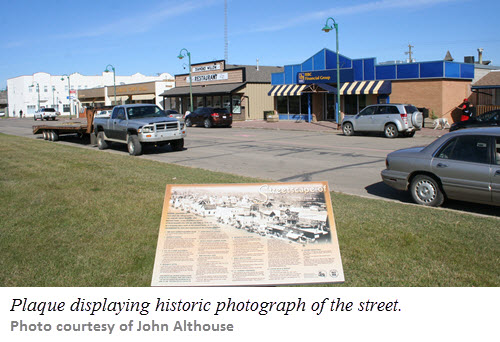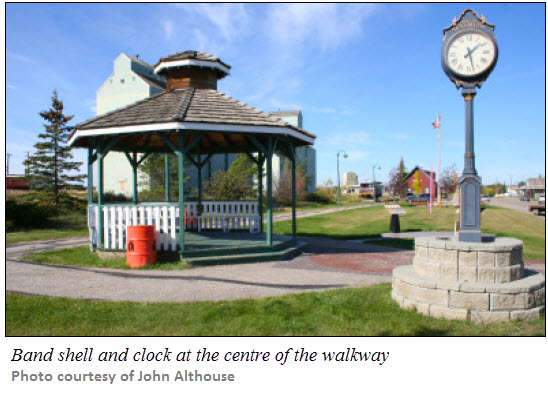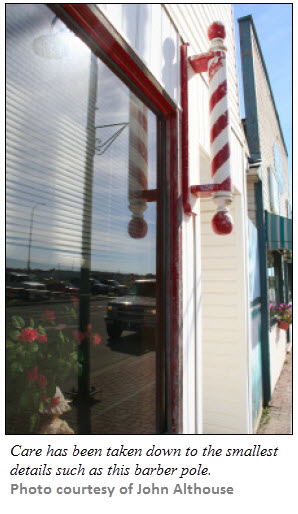Visiting Alberta’s Past
Sexsmith
by John Althouse
“Communities that once sustained, and were sustained, by agricultural surroundings, are dying.”
~ Elizabeth McLachlan, Herbert Has Lots for a Buck
By the early 1950s, small town newspapers across western Canada were expressing concerns about changes that were beginning to surface, but few truly saw the magnitude and how extensive they would be. These changes would ultimately not only alter the character of these communities but also result in a decline which would lead to many of their names permanently disappearing from the map. Fortunately, there were exceptions where citizens took initiative and acted to preserve appearance and spirit that once permeated most western Canadian towns.
Sexsmith, Alberta is one such community that has retained this small-town legacy. The town is situated in the South Peace Region just 20 kilometres north of Grande Prairie on Highway 2. In many ways, Sexsmith has remained the quintessential western Canadian town. In one respect, however, it is different from many others. The town’s railway station does not sit at the “T” where the main street abuts with the railway avenue. In Sexsmith, the main street and railway avenue are the same thoroughfare, named 100 Street. This is the focal point of the town’s historic revival. Along the east side of the street are the businesses of the town refurbished to look much as they did in the past. On the west side the railway line runs parallel to road but slightly set back from it. Along the track are the buildings associated with the trains.
 The side of the street on which the businesses are situated mirror their past. Most appear much as they did in the 1902s and 1930s. These buildings house vital, functioning businesses and services. A few have been constructed more recently, but they integrate almost seamlessly into the historic streetscape. As the work of renewal was carried out, attention was paid to the smallest details like a hand-painted barber pole and an outdoor clock in a traditional style. Every detail of the street enhances the sense that the visitor has stepped back in time as he or she strolls along the sidewalks in front of the businesses and views the wares held inside them.
The side of the street on which the businesses are situated mirror their past. Most appear much as they did in the 1902s and 1930s. These buildings house vital, functioning businesses and services. A few have been constructed more recently, but they integrate almost seamlessly into the historic streetscape. As the work of renewal was carried out, attention was paid to the smallest details like a hand-painted barber pole and an outdoor clock in a traditional style. Every detail of the street enhances the sense that the visitor has stepped back in time as he or she strolls along the sidewalks in front of the businesses and views the wares held inside them.
Across the street from these businesses, the railway line provides the theme. The 1928 Northern Alberta Railway station remains. Three grain elevators stand as silent sentinels of the past. There once were eight. This number suggests the importance that agriculture has had here, an importance that once earned Sexsmith the title of The Grain Capital of the British Empire. In the area between the tracks and the street is a grassy park. A paved walkway extends through this park for the length of the business area providing a great point from which to view, photograph, or simply contemplate the historic vista. In the middle of this park across from the centre of the businesses is a wooden gazebo. In front of the gazebo, there are three metal plates mounted on pedestals and oriented in different directions. Each plate bears a photo of the town as it was in its glory days. These photographs are aligned so one can look directly from this view of the past to the view as it exists today. The two views, upon comparison are remarkably similar.
Just behind the town offices and on 99 Street, Sexsmith has developed a local museum. The museum consist of two log buildings, a barn and a shop, dating from the years of World War I. This is a ‘blacksmith museum’ that pays homage to this once indispensable craftsman in every significant town in the Canadian west. It contains a thousand relics associated with his trade. The museum is operated by volunteers and is open from May to early September. Fonds related to the Sexsmith Blacksmith Museum can be found at http://www.southpeacearchives.org/fonds/fonds186.htm
Colourful facades alone do not recapture the essence of a lost past. It was marked by a unique atmosphere created by the residents. The historic streetscape of Sexsmith has brought elements of this character to life again. The street is alive, teeming with activity and where people take the time from their busy lives to stop and talk with their acquaintances and friends. The street continues to be  a social magnet drawing people to it. There is time to meet in the local café over a cup of coffee or a fine lite meal that is if one is able to avoid temptation and wend one’s way past the tempting aromas emanating from the bake shop situated just inside the entrance. People in the café, as in the other businesses, are pleasant, approachable, and helpful.
a social magnet drawing people to it. There is time to meet in the local café over a cup of coffee or a fine lite meal that is if one is able to avoid temptation and wend one’s way past the tempting aromas emanating from the bake shop situated just inside the entrance. People in the café, as in the other businesses, are pleasant, approachable, and helpful.
Although Sexsmith’s population is only about 2500 (2011), it is also the home of a post-secondary institution. The Peace River Bible Institute (PRBI) became a part of Sexsmith about 1935, and although fairly small for many years, it too has grown. The student/staff population fluctuates with the school  season and from year-to-year and has been as high as about 300 students and staff, making it about one tenth of the size of the town.
season and from year-to-year and has been as high as about 300 students and staff, making it about one tenth of the size of the town.
Recognized by the province of Alberta, the Peace River Bible Institute is a degree granting college. Courses offered by PRBI range between two and four years in length, and cover religious education, church music, pastoral studies and mission work. The college’s four year Bachelor of Religious Education course in ‘Church Ministry and Community Service’ can include fire-fighting certification with training provided through a partnership with the Sexsmith fire department.
Visitors to Sexsmith are able to experience first-hand a past that has vanished from much of western Canada. The town has been able to capture new vitality by looking back instead of ahead. The community continues to reflect the values of a simpler, less complicated time achieved through the determination of the citizens of Sexsmith. Their efforts have not only allowed the community to survive unlike many communities, but also to revitalize and perhaps even prosper by tapping its past. This summer take a little time to travel to Sexsmith, stroll along the town’s main street, and experience western Canada as it once was.
Originally appeared in Relatively Speaking, v.42 #2 (May 2014)
